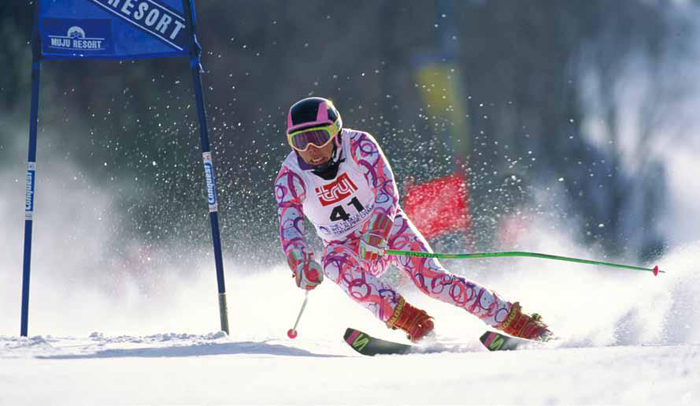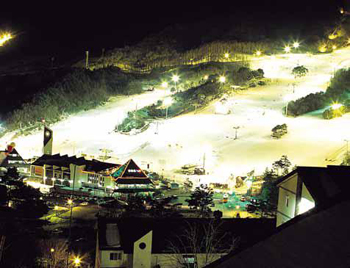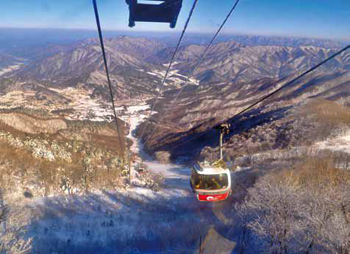View this article in another language
- 한국어
- English
- 日本語
- 中文
- العربية
- Español
- Français
- Deutsch
- Pусский
- Tiếng Việt
- Indonesian
While most travelers in Korea head to the wilds of Gangwon-do (Gangwon Province) in search of winter scenery, some of the best snowy vistas in the land can be enjoyed about two hours south of Seoul in the county of Muju, one of Korea’s biggest winter sports centers. The host of the 1997 Winter Universiade, Muju is blessed with high scenic peaks and plenty of snow—some of the heaviest snow fall in the country, in fact. On Deogyusan Mountain, the centerpiece of Deogyusan National Park, the wind and snow combine to produce a surreal landscape of “snow flowers” that mesmerize hikers intrepid enough to brave the heights and cold.

Muju Deogyusan Resort
Muju’s chief tourist draw is Muju Deogyusan Resort, one of Korea’s most popular ski destinations. The resort boasts both the country’s longest slope, the 6.1-kilometer Silk Road Course (vertical height of 810 meters), and steepest run, Raider’s Slope with a 70-degree incline. For those not training for the Olympics, a “Rookie Hill” is intended for beginners. The courses are also snowboarder-friendly.
The complex is modeled after the great alpine resorts of Austria, as undoubtably noticeable from the faux-alpine architecture. For the full Austrian experience, get a room in the resort’s five-star Hotel Tirol, where the suites are lined with Austrian larch. It’s like sleeping in an alpine forest. About 1,000 Austrian-style condo rooms are available, too. On Seolcheonbong Peak—where the gondola drops you off—an impressive three-story Korean pagoda cuts a pretty dramatic figure, especially when the snow and wind are up. From here is also a trail that leads to the peak of Deogyusan Mountain.
 Deogyusan National Park
Deogyusan National Park
Deogyusan Mountain is one of Korea’s higher peaks at 1,614 meters. The 20-kilometer main ridge sports several peaks of more than 1,000 meters. It’s a broad mountain, however, so while hikes are long, they aren’t especially arduous. The biggest danger in winter is the cold. Dress warmly and be prepared for the wind and snow. Be sure to wear crampons. To hike the main ridge will take about 12 hours, though it could take considerably longer if there’s deep snow—and there probably will be.
The ideal plan is to take in the sunrise from the peak. If you’re lucky, the clouds will be below you to form what Koreans call a “sea of clouds.” To do this, though, you need to spend a night at Hyangjeokbong Shelter. Be sure to call ahead to make a reservation as it fills up quickly. At the higher elevations are clusters of ancient yew trees, twisted by the elements into fantastic shapes. If you’ve got a camera, try to capture the trees’ silhouette against the morning sky.
Where to eat
Muju Deogyusan Resort has a wide selection of food and entertainment choices:
Korean and Western restaurants, snack stores, bars, noraebang and cafés. For something a bit more rustic, try eojuk, a spicy fish stew. Geumgang Sikdang (T. 063- 322-0979), near Muju County Office, is a good place to try. Interestingly, the region is known for making its own wine from wild grapes. The wine is aged in a renovated tunnel originally built for the construction of a hydroelectric plant.
 Where to stay
Where to stay
Muju Deogyusan Resort has three hotels: the deluxe Hotel Tirol, the Family Hotel, and the modest Kookmin Hotel.
The latter offers many sixperson rooms where visitors sleep on the floor and share a kitchen. Another option is to stay at the little village down the road or in an overnight sauna, called a jjimjilbang.
Getting there
Intercity buses depart from Seoul Nambu Bus Terminal to Muju Bus Terminal at 7:40am, 9:20am, 10:40am, 1:40pm and 2:35pm. From the back gate of the Muju terminal, in front of the Jeil Clinic, take the free shuttle bus to Muju Deogyusan Resort.
* An article from Korea Magazine (January 2014)
Downhill skiing at Muju
Muju Deogyusan Resort
Muju’s chief tourist draw is Muju Deogyusan Resort, one of Korea’s most popular ski destinations. The resort boasts both the country’s longest slope, the 6.1-kilometer Silk Road Course (vertical height of 810 meters), and steepest run, Raider’s Slope with a 70-degree incline. For those not training for the Olympics, a “Rookie Hill” is intended for beginners. The courses are also snowboarder-friendly.
The complex is modeled after the great alpine resorts of Austria, as undoubtably noticeable from the faux-alpine architecture. For the full Austrian experience, get a room in the resort’s five-star Hotel Tirol, where the suites are lined with Austrian larch. It’s like sleeping in an alpine forest. About 1,000 Austrian-style condo rooms are available, too. On Seolcheonbong Peak—where the gondola drops you off—an impressive three-story Korean pagoda cuts a pretty dramatic figure, especially when the snow and wind are up. From here is also a trail that leads to the peak of Deogyusan Mountain.
Nighttime skiing at
Deogyusan Mountain is one of Korea’s higher peaks at 1,614 meters. The 20-kilometer main ridge sports several peaks of more than 1,000 meters. It’s a broad mountain, however, so while hikes are long, they aren’t especially arduous. The biggest danger in winter is the cold. Dress warmly and be prepared for the wind and snow. Be sure to wear crampons. To hike the main ridge will take about 12 hours, though it could take considerably longer if there’s deep snow—and there probably will be.
The ideal plan is to take in the sunrise from the peak. If you’re lucky, the clouds will be below you to form what Koreans call a “sea of clouds.” To do this, though, you need to spend a night at Hyangjeokbong Shelter. Be sure to call ahead to make a reservation as it fills up quickly. At the higher elevations are clusters of ancient yew trees, twisted by the elements into fantastic shapes. If you’ve got a camera, try to capture the trees’ silhouette against the morning sky.
Where to eat
Muju Deogyusan Resort has a wide selection of food and entertainment choices:
Korean and Western restaurants, snack stores, bars, noraebang and cafés. For something a bit more rustic, try eojuk, a spicy fish stew. Geumgang Sikdang (T. 063- 322-0979), near Muju County Office, is a good place to try. Interestingly, the region is known for making its own wine from wild grapes. The wine is aged in a renovated tunnel originally built for the construction of a hydroelectric plant.
The gondola will get you
Muju Deogyusan Resort has three hotels: the deluxe Hotel Tirol, the Family Hotel, and the modest Kookmin Hotel.
The latter offers many sixperson rooms where visitors sleep on the floor and share a kitchen. Another option is to stay at the little village down the road or in an overnight sauna, called a jjimjilbang.
Getting there
Intercity buses depart from Seoul Nambu Bus Terminal to Muju Bus Terminal at 7:40am, 9:20am, 10:40am, 1:40pm and 2:35pm. From the back gate of the Muju terminal, in front of the Jeil Clinic, take the free shuttle bus to Muju Deogyusan Resort.
* An article from Korea Magazine (January 2014)